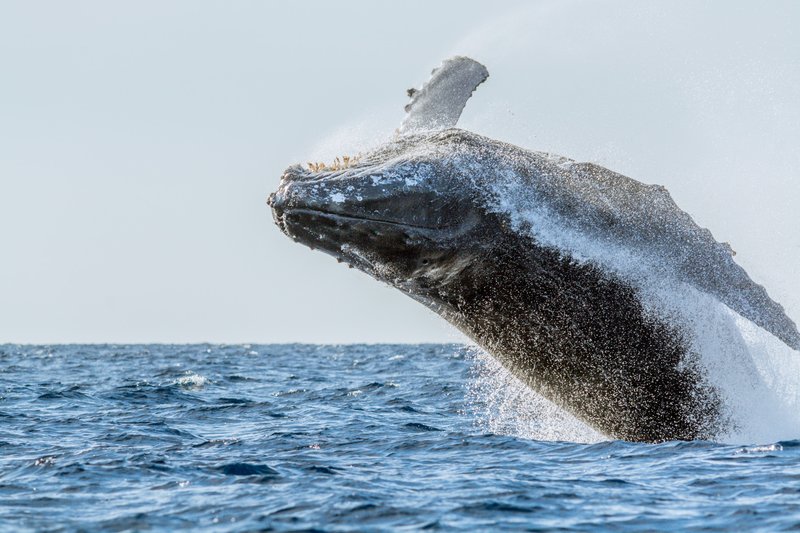Humpback Whale
Introduction
The Humpback Whale is a large baleen whale that migrates annually along the east and west coasts of Australia.
What do Humpback Whales look like?
Identification
The Humpback Whale has distinctive knobbly protuberances on the head and long flippers making this one of the most easily recognised of the large baleen whales. Its name is derived from the hump under the dorsal fin, which is particularly noticeable when the whale arches its back to dive. This is one of the most studied of the great whales as individuals can be recognised by characteristic black and white patterns especially on the underside of the tail.

© CC BY-NC 4.0
Where do Humpback Whales live?
Habitat
The Humpback Whale generally inhabits the open ocean, except during the annual migration between cold water feeding areas and the warmer calving grounds. During this time they will often appear quite close to the coast and on the journey south (in the Southern Hemisphere) will congregate for short periods in sheltered bays on route.
Additionally, in winter breeding and birthing areas, mother-offspring pairs often prefer shallow waters less than 20 metres deep, typically near offshore reed beds, islands, and channels.
Distribution
Humpback Whales have a worldwide distribution involving two broad population groups that do not appear to mix - one in the Northern Hemisphere and one in the Southern Hemisphere. Humpback Whales are found in the waters off coastal Australia.
What do Humpback Whales eat?
Feeding and diet
Humpback Whales feed on a number of marine invertebrates (mainly krill in the Southern Hemisphere) and small schooling fish. They use several techniques to catch prey, often herding fish into dense groups to make lunge feeding more efficient. One well-known method is bubble-net feeding. In this technique, a group of whales dives beneath a school of fish while one whale swims in a tightening circle, blowing a ring of bubbles. As the bubbles rise, their noise and reflections frighten the fish, driving them into a tighter formation. Once the fish are near the surface, the whales lunge upward through the bubble net with their mouths open. They then expel the water through their baleen plates, trapping the fish inside before swallowing them. This cooperative feeding strategy can involve up to 15 individuals working together.
What is the life cycle of Humpback Whales and how do they breed?
Seasonality
The Humpback Whale spends summer in the Antarctic, feeding on krill, before travelling north during winter to breed. The best time to see these whales off the coast of Sydney is in June, July and August.
Life history cycle
Humpbacks are long-lived animals that do not reach sexual maturity until they are at 4-5 years old, but in some areas that figure could be closer to 8 years. After a 12-month gestation, a single calf is born and typically remains with its mother for about a year. Females usually give birth every 2–3 years.

© CC BY-NC 4.0
Breeding behaviours
The breeding season is characterised by the winter migration to warm tropical waters and the long complex sounds or songs produced by the males during the journey. The reason for these calls is not known but it could be a combination of sexual and territorial display.
Are Humpback Whales endangered?
Conservation status
Because whales provided valuable meat and oil products, whaling stations were established along the coast and the Humpback Whale was hunted almost to extinction. The numbers of Humpback Whales crashed during the peak of the whaling industry especially in the 1960s and 1970s. The Humpback Whale has been protected in the Southern Hemisphere since 1963 and a worldwide moratorium on whaling was declared in 1986.
The current estimate of the Humpback Whale population in the Southern Hemisphere has recovered to approximately 36,400 individuals. However, they continue to face ongoing threats from human activities, including entanglement in fishing gear, ship strikes, shipping noise, and habitat degradation.
Support the Australian Museum
Your donation supports the exceptional work of our inspiring scientists, explorers and educators as they help to protect Australia’s vital natural and cultural heritage for generations to come.
Donate nowReferences
- Baker, A. N. 1999. Whales and Dolphins of Australia and New Zealand: an identification guide. Allen & Unwin, St Leonards, Australia.
- Bryden, M., Marsh, H. and Shaughnessy, P. 1998. Dugongs, Whales, Dolphins and Seals. A guide to the sea mammals of Australasia. Allen & Unwin, St Leonards, Australia.
- Menkhorst, P. 2001. A Field Guide to Mammals of Australia. Oxford University Press, Melbourne, Australia.
- Reeves, R. R., Stewart, B. S., Clapham, P. J. and Powell, J. A. 2002. National Audubon Society Guide to Marine Mammals of the World. Chanticleer Press, Inc New York, USA.


